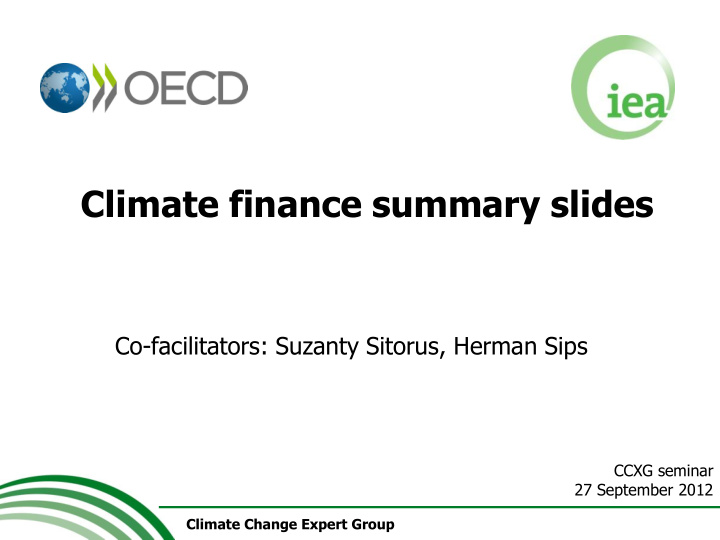



Climate finance summary slides Co-facilitators: Suzanty Sitorus, Herman Sips CCXG seminar 27 September 2012 Climate Change Expert Group
Defining mobilised – key points • Many instruments used to mobilise CF • Financing needs depend on type of project (within mitigation, also adaptn/mitigation) • Causality important – but how to determine? • Careful not to create perverse incentives (e.g. if we exclude non-concessional loans) • Guidance on what counts as mobilised would be helpful … but may be difficult to establish. Possibly start with what doesn’t count • Distinguish what counts as climate finance from what counts for 100bn Climate Change Expert Group 2
Effectiveness of mobilisation – key points • No agreement yet on what “effectiveness” is • Context important in encouraging private investment (enabling environment, NPV of project) • Different financial instruments needed in different contexts • No clarity on which flows should be included (e.g. domestic NAI flows) Climate Change Expert Group 3
Assessing “mobilised” and “leveraged” • We need increased transparency of climate finance reporting • Mobilised/leveraged assessment could be done top- down or bottom up - bottom-up might give us more complete picture. • Both donors and recipients have only partial picture of climate finance outflows/inflows. • Significant use of intermediaries – does this impact double counting? Climate Change Expert Group 4
Assessing “mobilised” and “leveraged” ( cont) • Ownership of recipient is a key issue, and identifying actual ownership can be challenging. Political questions as well as technical ones: if donor country provides climate finance to donor country owned entity in a developing country, does this count? • In terms of guidance, could be useful to have this on MRV at an aggregated level. Defining what finance is additional would also require information on (financial) baselines, so guidance/transparency could be needed here too. Climate Change Expert Group 5
Look at “green” in context Climate Change Expert Group 6
Leverage • No agreement yet on what this is or how to define it. (Nor distinction leverage, mobilise , catalyse, drive …) • Finance is a means to an end – achieving climate resilience • Look at green in context of brown investment • Mobilising is a complex art. There is no unique, agreed definition of or methodology for defining leverage - need to be very transparent. • Leverage depends not only on instrument, but also on barriers being addressed, intermediary/institutions used, national circumstances, risk/return profile etc.. Climate Change Expert Group 7
Leverage (cont) • A variety of financial instruments and institutions will be needed – don’t restrict it to a few. • NDBs could play an important role in mobilising climate finance, and may better know/align with country priorities • There is a large variation in and complexity surrounding developing robust leverage ratios. Coming up with one number will be difficult • Careful to not focus just on leverage - not the only indicator of success… but can indicate potential • Focusing only on leverage ratios can divert attention from actions/projects with other positive impacts (development, environment etc…) Climate Change Expert Group 8
Eligible project types and flows • Don’t be too restrictive on project types, which are affected by nat’l circs – especially for adaptation • Origination is clear for public, but complex for private sources. Data challenges. • Timing important - when is finance mobilized: pledged, committed, disbursed, received? Data challenges. • Does internally-mobilised / S-S investment count? Climate Change Expert Group 9
Suggested future work 1. Case studies Instruments; different institutions; how to address risks; outflows and inflows 2. Methodological work Landscape of private finance; causality/baseline; effectiveness; leverage ratio 3. Workshop suggestions A session on modus operandi and constraints of NDBs. How have they mobilised and how could this be improved in future? Climate Change Expert Group 10
Recommend
More recommend